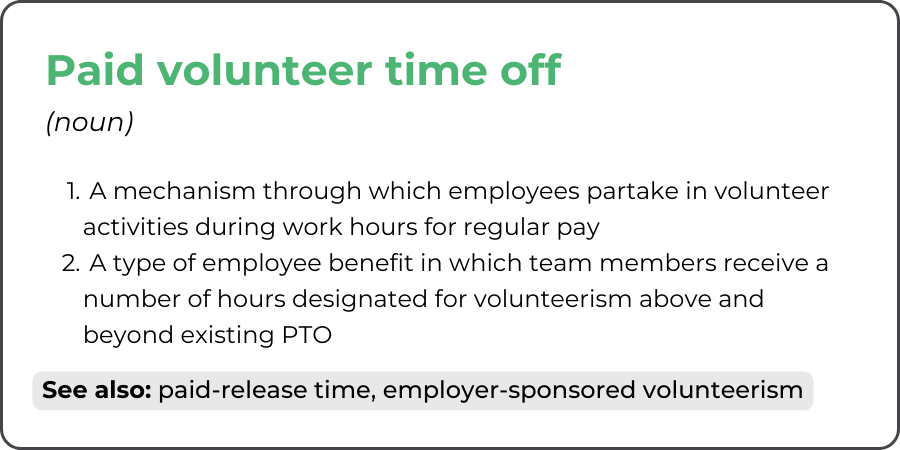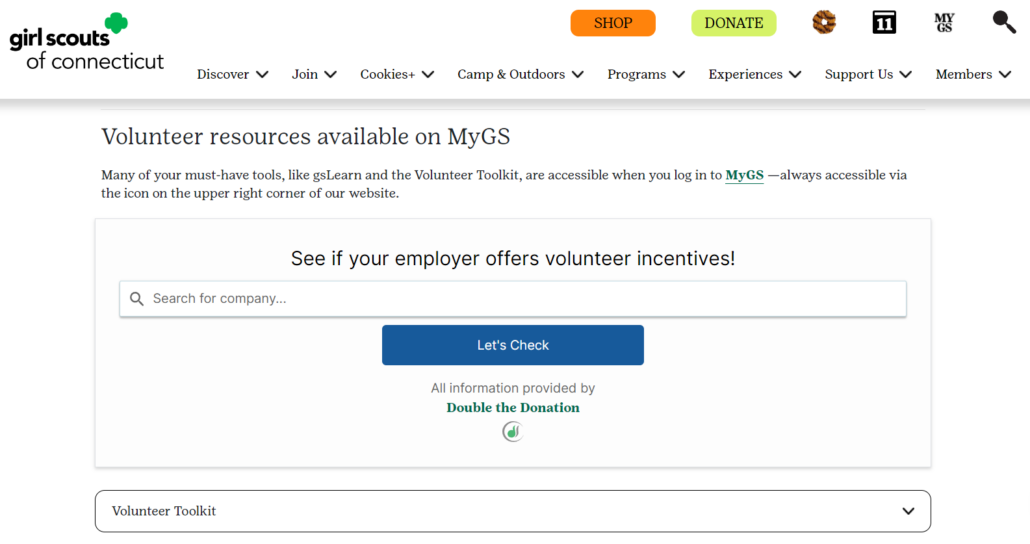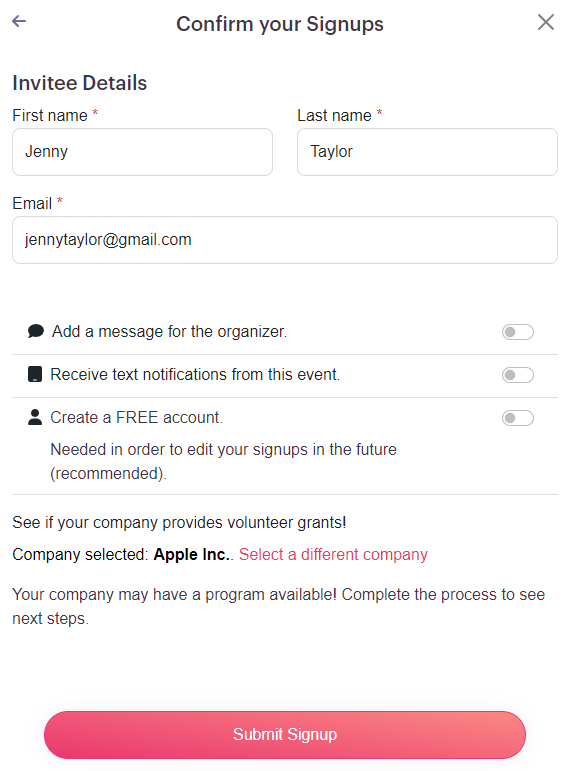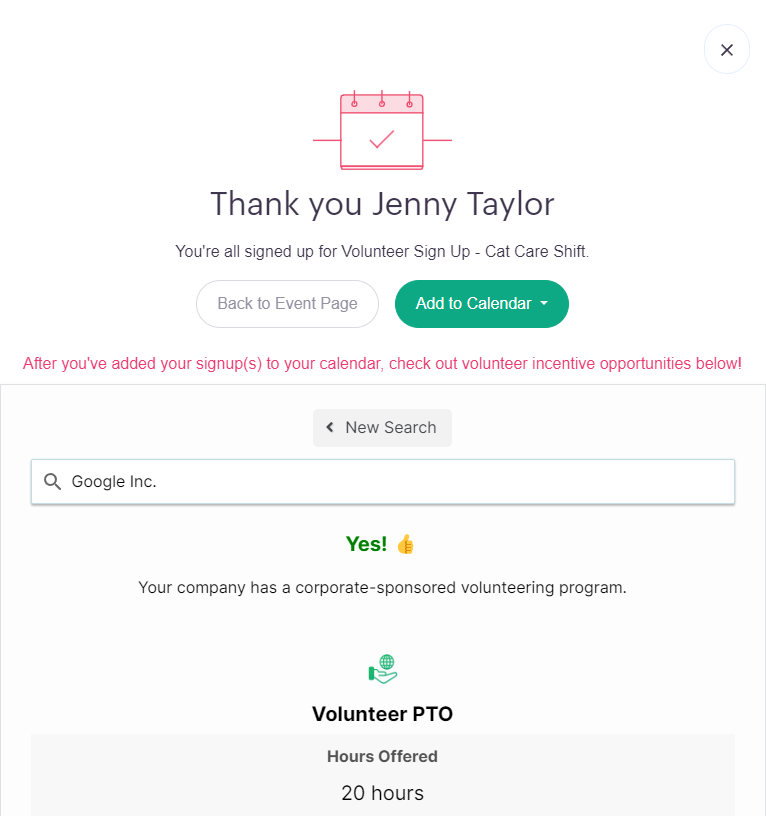Volunteer Time Off Programs: A Smart Nonprofit’s VTO Guide
In today’s socially conscious landscape, companies are increasingly embracing Corporate Social Responsibility initiatives that benefit both their employees and the communities they serve. One standout program that fits both criteria is Volunteer Time Off, which offers employees paid time to volunteer for causes they’re passionate about.
For nonprofits, understanding how to tap into these VTO programs can open doors to a vast pool of dedicated volunteers. This guide will help nonprofits navigate the world of volunteer time off, offering strategies to engage employees who are looking for meaningful ways to give back through their company-sponsored volunteerism. And we’ll do so by answering the following frequently asked questions:
- What is Volunteer Time Off?
- Why do companies offer Volunteer Time Off?
- How do nonprofits benefit from Volunteer Time Off?
- How can nonprofits market VTO opportunities to volunteers?
To fully leverage Volunteer Time Off programs, nonprofits need a solid understanding of how they work, why companies offer them, and the benefits these programs bring. By exploring the answers to these key questions, organizations like yours can position themselves to attract more corporate volunteers, build lasting partnerships, and maximize the impact of VTO.
Without further ado, let’s start by addressing the fundamental question: What is Volunteer Time Off?
What is Volunteer Time Off?
Volunteer Time Off—also known as VTO—is a corporate benefit that allows employees to take paid time off from work to volunteer for charitable or community service activities. This time off is typically offered above and beyond any other forms of leave (like vacation or sick days), as it’s specifically designated for volunteerism.

VTO encourages employees to engage in community service, support nonprofits, and contribute to causes they care about—without having to give up their pay or schedule around existing work commitments. This makes it easier for individuals to participate in volunteer activities, driving additional support for nonprofit causes.
Within the programs, companies generally establish policies regarding how much VTO is available per year (often between 8 and 40 hours) and may specify eligible nonprofits or activities.
Why do companies offer Volunteer Time Off?
Companies offer Volunteer Time Off for several reasons, often tied to their broader Corporate Social Responsibility (or CSR) goals and employee engagement strategies.
Here are key reasons why companies implement VTO programs:
- Enhance Corporate Social Responsibility: Offering VTO allows companies to demonstrate their commitment to giving back to the community. It aligns their business with charitable and social causes, enhancing their CSR profile and showing that they prioritize social impact.
- Boost Employee Engagement and Morale: VTO empowers employees to contribute to causes they care about without sacrificing their income. This not only increases job satisfaction but also boosts overall morale and fosters a sense of purpose in the workplace.
- Attract and Retain Talent: Many employees, particularly those in the younger generations, prioritize working for companies that are socially responsible. VTO programs are an attractive benefit that can help companies recruit socially conscious talent and improve employee retention overall.
- Enhance Company Reputation: VTO programs reflect positively on a company’s public image. By showing a commitment to community service, companies improve their reputation with customers, clients, and the public, ultimately driving brand loyalty.
- Strengthen Community Ties: Companies that support local volunteer efforts build stronger relationships with the communities where they operate. These ties can lead to a more supportive business environment and potential partnerships with community organizations.
Overall, VTO programs allow companies to align their business objectives with meaningful social contributions, benefiting both their workforce and the communities they serve.
How do nonprofits benefit from Volunteer Time Off?
Nonprofits gain several valuable benefits when their supporters participate in Volunteer Time Off programs. These corporate-sponsored initiatives bring new resources, energy, and opportunities for collaboration. This includes benefits such as…
- Access to Skilled Volunteers: Employees who participate in VTO often bring diverse skill sets from their professional backgrounds, providing nonprofits with access to talent that might otherwise be unaffordable. This expertise can help nonprofits improve their operations in areas like marketing, finance, IT, and project management.
- Enhanced Volunteer Engagement: VTO programs encourage participation from employees who might not typically volunteer on their own. By tapping into these corporate volunteers, nonprofits can significantly expand their volunteer base and complete larger or more complex projects.
- Increased Awareness and Visibility: When employees share their volunteer experiences with their colleagues, friends, or others in their networks, it increases awareness of the nonprofit’s mission and activities. This exposure can attract more volunteers, donors, and supporters to your cause overall.
- Strengthened Corporate Relationships: Collaborating with companies through VTO programs strengthens a nonprofit’s relationship with the business community. These relationships can lead to further corporate giving opportunities, such as matching gifts, sponsorships, or event collaborations.
How can nonprofits market VTO opportunities to volunteers?
Nonprofits can effectively market Volunteer Time Off opportunities by targeting corporate employees and companies in ways that highlight the mutual benefits of the program.
Here are a few leading strategies to attract volunteers through VTO:
1. Create a Dedicated Corporate Volunteering Page:
Create a section on your nonprofit’s website specifically for corporate volunteering opportunities. Highlight how employees can utilize their VTO to support your cause and make it easy for them to sign up for upcoming events and activities.
Plus, to make identifying VTO programs as quick and simple as possible, we recommend embedding a corporate giving database directly into the page.

2. Promote VTO in Volunteer Registration Forms:
Ensure your volunteer registration forms prominently feature Volunteer Time Off (VTO) options for corporate employees. Include an optional form field that asks whether the individual is using VTO, and make sure to collect employment information
n as you do so. This not only helps you track corporate volunteers but also allows you to tailor communications and deepen relationships with their employers.
To streamline the process, consider integrating your sign-up forms with a tool like Double the Donation Volunteering, making it easy for volunteers to check if their company offers VTO or other charitable programs.
Step 1)

Step 2)

3. Leverage Social Media:
Spread the word about Volunteer Time Off using your organization’s social media profiles! Share stories, photos, testimonials, and more—highlighting past corporate volunteer groups to increase visibility and attract new supporters. (P.S. Double the Donation clients can access free, customizable marketing templates to promote VTO programs, volunteer grants, and more!)

You can even encourage current volunteers to share your VTO content with their networks, amplifying your outreach and increasing the likelihood of reaching more eligible supporters.
4. Send a Follow-Up Email:
After a corporate volunteer event, it’s essential to maintain engagement by sending a follow-up email to participants. In this email, express your gratitude for their contributions and share the impact of their efforts on your nonprofit’s mission. Additionally, remind them about their company’s Volunteer Time Off program and encourage them to utilize it for future volunteer opportunities with your organization (or to submit their paperwork to get credit for their most recent activity).
5. Partner with Companies:
Build relationships with businesses that have existing VTO programs. Reach out to HR departments or CSR managers and present your nonprofit’s mission and available volunteer opportunities as key ways for their employees to get involved.
For the best results, you can even organize tailored volunteer activities that align with a company’s core values or industry. For example, a tech company may be interested in hosting a coding workshop for underprivileged students, while a healthcare company might prefer to sponsor a community health fair or organize volunteer shifts at a local clinic.
Regardless, by taking a proactive approach and positioning your organization as a valuable partner for VTO, nonprofits can attract more corporate volunteers and create lasting relationships with companies that support meaningful community engagement.
Final Thoughts & Additional Resources
Volunteer Time Off supplies a win-win-win situation for everyone involved. From the companies offering the programs to the employees who participate and the nonprofits receiving their support, everyone benefits.
For nonprofits, knowing how to leverage these programs can lead to stronger community partnerships, increased volunteer participation, and greater impact. By positioning your organization as a go-to option for corporate volunteers, you not only gain valuable resources but also build lasting relationships that could lead to future support.
Embrace the potential of VTO. Then, watch your nonprofit thrive with the help of motivated, passionate volunteers—and the support of their employers!
Ready to learn more about Volunteer Time Off and how you can benefit from the programs? Check out these additional resources:
- Standout Strategies for Leveraging Corporate Volunteer Incentives. Maximize your impact by tapping into corporate volunteer incentives. Access tips for identifying companies with volunteer initiatives, building partnerships, and engaging corporate volunteers to support your mission.
- Tracking Volunteer Time Off: A How-To Guide [& Template]. Effectively tracking and managing Volunteer Time Off is crucial. This resource provides a step-by-step look at how to track VTO hours and more. Plus, get a free template to simplify the process.
- A Complete Look at Volunteer Grants For Fundraisers. Volunteer grants are another popular form of corporate incentive. In these initiatives, companies provide generous funds to the organizations with which their employees volunteer. Learn more about the programs here!





